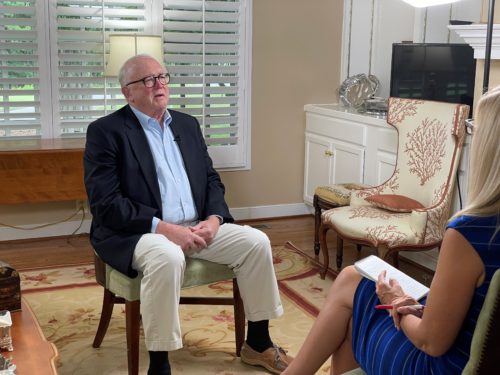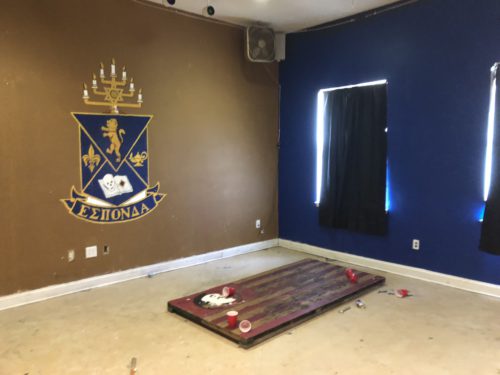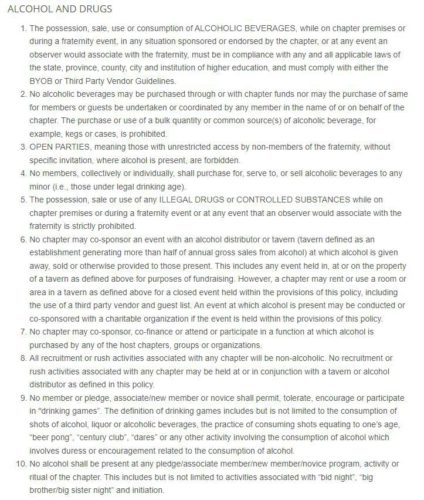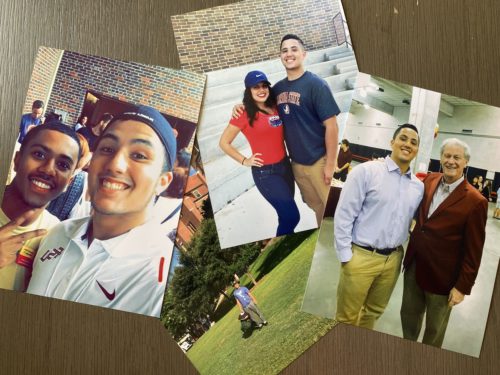By Jill Riepenhoff, Joce Sterman, Austin Hedgcoth and Olivia Oliver
YORKVILLE, ILL. (InvestigateTV) – In the months after her son was brutally injured in a fraternity hazing incident at Florida State University in 2018, Michelle Mauricio was becoming increasingly desperate.
She didn’t have the financial means to provide the kind of medical care that her son Nicholas needed to assist his recovery from a broken skull and brain bleed that left lasting and serious issues.

Nicholas Mauricio shares pictures of himself after experiencing a traumatic brain injury stemming from a fraternity hazing incident. He spent five days in an intensive care unit. Photo credit: Mauricio family
She pressed her lawyer to quickly settle a civil suit against the fraternity brothers who orchestrated the hazing ritual and the organization’s national headquarters.
And when the cases were resolved, she was surprised to learn the sources of some of the settlement payments: homeowners’ insurance policies.
She assumed that all the money would be paid out by the national Alpha Epsilon Pi’s liability insurance premium.
“I was shocked, shocked because nobody explained that in orientation,” she said. “A parent needs to know that, right? . . . You make a stupid mistake and now the parents got to pay.”
It’s a well-known secret within the fraternity industry that while its undergraduate members foot the bill for expensive liability insurance, when something goes wrong, those students largely are left without coverage while headquarter executives and the national organizations are generally fully protected.
“It’s an amazing thing. The kids are paying all the insurance money, the entire premiums for the nationals, and they’re not covered,” said David Easlick, a former executive director of Delta Kappa Epsilon. “It’s meaningless insurance. They are absolutely paying for nothing.”

Former fraternity executive David Easlick is not an expert witness against fraternities in hazing cases across the country. Photo credit: Scotty Smith
Nicholas Mauricio is one of countless young men who have been injured when a fraternity hazing ritual turned dangerous. But he’s among the lucky ones. Between 1970 and 2021, hazing contributed to the death of a fraternity member or pledge every year.
Since 2000, 67 young men have lost their lives, InvestigateTV has found.
And while the families of hazing victims try to rebuild, they also attempt to seek accountability from those that harmed their sons by filing civil lawsuits.
But many national organizations have found a way to shield themselves and shift much of the blame on to the young men they call brothers, InvestigateTV has found through an exhaustive analysis of fraternities’ federal tax records, internal memos and policy guidelines and court records.
They have created their own insurance companies and put in place rules that exclude from coverage any undergraduate member involved in hazing, alcohol abuse – including drinking games or buying a keg – or sexual abuse even though the national organizations are well aware of these risky behaviors happening at their chapters.
“It’s a culture of secrecy. It’s an insular male organization that is reticent to changing and changing in ways that will keep people alive,” said Douglas Fierberg, a Michigan-based lawyer who has represented dozens of families whose sons and daughters were injured or killed in a hazing incident.
In many ways, today’s fraternities were shaped by a popular movie, a traditional insurance industry unwilling to take on their risks, internal policies creating ways to place the blame largely on its undergraduate members and their long-standing cultures of secrecy.
All those forces came into play when Alpha Epsilon Pi at Florida State named Nicholas Mauricio as the “Scumbag of the Week” in the spring of 2018.
Fraternity executives push oversight and blame to local chapters
At the first chapter meeting Mauricio attended as a brother, he learned about a long-standing tradition – to single out a member for discipline.
Mauricio said other members thought he was napping too much around the fraternity house. For that transgression, he was to receive a slap to the face by another young man who was not a member of the fraternity nor a Florida State student.
The man cocked his arm and delivered a knock-out punch. Mauricio fell backward and hit his head on the cement floor.
“I feel more than betrayed,” Mauricio said. “And I feel let down by kids that promised me that they would have my back.”
He awakened in an intensive care unit and spent five days there, according to the family’s lawsuit. His mother said that fraternity members told her that he had slipped in the rain and fell down a flight of stairs after playing basketball.
“If you put all the pieces together…it was intentional,” Michelle said.
Nicholas, she said, was a victim of hazing.

Michelle and Stephanie Mauricio snapped photos like this one of the Alpha Epsilon Pi fraternity house during a visit following a hazing incident that left Nicholas Mauricio with a traumatic brain injury. Photo credit: Mauricio family
Just months before, at another fraternity house at Florida State, Andrew Coffey died of alcohol poisoning after a big brother event in which the little brothers – or pledges – were pressured to consume dangerous amounts of alcohol.
Big brother rituals are among the “three deadly nights,” a term coined by a former Theta Chi executive, David Westol, who served in that role from 1988 to 2006, and is widely known by fraternity executives.
Those deadly nights include bid night, big brother night and pre-initiation events when alcohol is involved.
At least 18 of the 67 fraternity deaths that have happened since 2000 were tied to one of those three events, an InvestigateTV analysis shows.
Critics say that’s proof that the national organizations are keenly aware of the risky behaviors happening at their chapters across the country.
Yet those national fraternities crafted a policy – and a set of talking points – in an attempt to absolve them of liability, an internal memo provided to InvestigateTV by Fierberg shows.
The fraternity executives never meant for the document to be made public. But somehow, it ended up online briefly, where Fierberg found it.
The confidential internal memo was presented at the 2012 Fraternity Executives Association annual meeting and discusses a concept known as “conscious separation.”
Fierberg calls it a charade to avoid liability.
Executives are encouraged to take a hands-off approach to regulating activities at local chapters because “more involvement = more potential liability” and “prior knowledge of improper acts is fatal,” the memo says.
It places much of the responsibility on local fraternity officers – students – to police the chapter and enforce rules.
In situations where serious problems arise resulting in legal action, the memo advises executives to “include other potentially liable parties to share the fun.”
It offers what it called creative settlement techniques to deflect responsibility at the national level, including using members’ individual homeowners’ policies to “make the bad actor pay.”
Asked whether the memo was a smoking gun, Fierberg said, “It’s a gun they never wanted to be seen. And it’s a gun that they would do their level best to prevent the public from knowing about. They know exactly what they’re doing. This isn’t the only time, I’m sure, that they were presented ways to evade litigation and responsibility.”

Attorney Doug Fierberg, who has represented victims of hazing across the country, says national fraternities have long escaped full accountability. Photo credit: Scotty Smith
The secretive policy of deflecting responsibility toward its undergraduate members has played out in numerous civil court cases where someone was injured or killed at a fraternity house.
“We don’t do oversight, we provide support. We’re an education, self- governance organization. So, we provide support to our student chapters,” one fraternity executive explained in a May 2023 deposition.
Another said in 2018, “We’re not really monitoring chapter activities. And we are responding to — so we are educating, training, and providing resources to help chapters understand these bylaws and to operate efficiently and safely and for the benefit of their members. And so, if there are bylaws, a chapter’s bylaws are out of whack, it’s up to the chapter and the membership to say, ‘We’re not going to put up with this.’”
And yet another, when asked who at the national office ensures compliance at local chapters, the vice president of the national fraternity simply said, “No one.”
Risk management policies prohibit hazing and alcohol-fueled parties
According to fraternity executive-turned-expert witness Easlick, fraternities were a dying breed in the 1970s, with membership steadily declining.
But in 1978, the movie National Lampoon’s Animal House, about a fictional fraternity, breathed new life into the Greek system and fundamentally changed the way real-life fraternities operated.
The movie glamorized binge drinking and hazing. Membership in real life soared.
By the mid-1980s, though, insurance companies had seen enough as at least 15 young men lost their lives in alcohol- and/or hazing-related deaths in the six years since the movie’s release, an InvestigateTV analysis of deaths shows. In the 18 years prior, the death toll was just 13.
Insurance companies abandoned the fraternities, ranking them as the 6th worst risk in the industry, fraternity records show. Hazardous waste disposal companies ranked 7th.
But many fraternities banded together and created their own risk management plans and insurance pools. David Easlick was among the fraternity executives seeking a solution at the time.
“It gave leverage to the fraternities for the first time, they could really collect money from the undergraduates and count on their loyalty and get their money,” he said.
The executives created a list of risk management guidelines that still apply today. The guidelines prohibited drinking games, supplying alcohol to minors, buying alcohol with chapter funds, purchasing kegs, using alcohol during the so-called three deadly nights and hazing.
Page 26 of a 40-page risk management manual examined by InvestigateTV explains that the liability insurance excludes coverage in cases of hazing, leaving students to rely on their parents if there is a claim after someone is injured or killed.
The guidelines, which some fraternities currently post online, also suggest – but do not insist – that the insurance coverage, limitations, exclusions and cost be discussed annually at each chapter. It’s unknown if this happens.
“It’s essentially a big joke,” Easlick said of the guidelines. “Visit any campus on a weekend and the biggest parties are always happening at the fraternity houses.”

One set of fraternity risk management guidelines publicly available online shows their rules prohibit behavior that experts argue is fairly typical within fraternities.
But those risk management policies also put in place a provision that would void liability coverage if its undergraduate members violated any of those guidelines.
So when someone dies or is harmed during a hazing ritual and a lawsuit is filed, the fraternity brothers involved are left essentially uncovered by the national organization’s policy even as headquarters has pocketed premiums from them semester after semester.
“So now you have a circumstance where the national fraternities actually profit on the insurance companies that they own, related to the risk that they create and refuse to change,” Fierberg said.
InvestigateTV analyzed the most recent three years of tax returns from 63 national fraternities and found that membership dues largely fund their multimillion-dollar operations, including paying the six-figure salaries of the executive directors.
Undergraduate members are required to pay dues to retain membership in the fraternity. About half of the money stays with the local chapter to fund its operations; the remainder is sent to the national headquarters, Easlick said.
Tax records show that one national fraternity has nearly $20 million in assets, largely derived from its liability premiums charged to students as dues. Another has more than $7 million.
Most fraternities have insurance through one of three companies of which they are owners or have a stake in ownership, tax records show. That ownership amounts to additional financial assets each year ranging from about $100,000 to more than $2 million, tax records show.
“This is just nuts,” Easlick said. “It’s a terrible thing because what they’ve done is they’ve taken away the coverage for the individuals.”
Favor & Company, one of several fraternity insurance companies contacted by InvestigateTV, said in a statement that “good behavior should be recognized and supported and criminal behavior should be accountable under the law. Members who fail to comply with organizational policies should not expect coverage for those acts. No insurance policy is designed to provide protections for violations of the law.”
While not all national fraternities operate this way, InvestigateTV found that many are able to shift liability for hazing and alcohol incidents, back onto fraternity members.
The North American Interfraternity Conference, the lobbying group that represents fraternities, would not do an interview but wrote in a statement that its members are committed to health and safety as evidenced by those risk management policies.
After reviewing InvestigateTV’s findings, the conference added, “NIC member organizations encourage accountability when laws are broken and people are harmed, which is exactly why they do not provide coverage for actions that intentionally endanger others, break the law or violate fraternity policies.”
It also wrote that it is actively lobbying for stronger federal and state hazing laws to increase criminal penalties and provide greater transparency.
Six other organizations and individuals that represent fraternity executives, advisors, attorneys or their insurance companies, which were repeatedly contacted since June, did not provide a comment with some citing confidentiality issues.
‘A battle for the rest of my life’
The punch that knocked out Nicholas also knocked his family’s world off its axis.
His brain injuries were so severe that he needed special treatment and rehabilitation services that required relocating from their home in southern Florida to the Chicago, Illinois area.
Nicholas “suffers from encephalomalacia, or a dead area in his brain. The damage done to his right frontal lobe affects his behavior, mood, attitude, and cognitive function,” according to his lawsuit against Alpha Epsilon Pi and some of its Florida State members. “He suffers from memory problems, migraines, paranoia, post-traumatic stress, panic attacks and difficulty in group settings. In addition, due to the force of the blow to his face and the subsequent strike to his head on the floor, he also suffers from injuries to his neck and back.”
That punch also delivered another devastating blow: Nicholas’ dream to be the CEO of a Fortune 500 company would be delayed, if not destroyed. He had to drop out of Florida State.
“I feel burned. I feel more than betrayed,” Nicholas said. “I feel let down by kids that promised me that they would have my back.”
Now 25, many of Nicholas’ days are occupied by rehabbing his physical and mental self. He said it’s a “long, strenuous journey. Felt like it’s been a trip to hell and back.”
Every day, he said, is a battle, “and it will be a battle for the rest of my life.” His mother and younger sister, Stephanie, provide support.
“Our whole family has been destroyed by this. Well, almost destroyed. We’re stronger than that. But it has, it’s really put a toll on our family,” Michelle said.
She misses most the spark in Nicholas’ eyes. “It’s not there anymore,” she said.

Before a hazing incident that resulted in a traumatic brain injury, Nicholas Mauricio’s family says he was an exuberant young man with a constant smile that lit up the room. These photos document his early days at Florida State. Photo credit: Mauricio family.
The family settled the lawsuit against Alpha Epsilon Pi, the local members and the boy who delivered the punch. The terms of the settlement are confidential.
Contacted for comment, Alpha Epsilon Pi national spokesman Jon Pierce sent the following statement:
“We are not going to add to the story about an incident which took place many years ago and has been settled by all parties. In late 2018, AEPi began a restructuring of our health and safety strategies beginning with a full audit of our risk management program. We have subsequently developed innovative and best-in-class online teaching tools which are mandatory for all members (as they have been since 2018). This portal includes revised policies and procedures. AEPi continues to invest in its health and safety program: retraining all staff, investing in more staff working with undergraduates, and working with parents to develop preventative and early warning systems to identify students who may be battling such things as addiction or mental health challenges. Nothing can be done to completely eliminate risk, but we work hard every day to educate and train our members and reform risky behaviors.”
But Nicholas believes the national organization was not fully held to account.
“They kind of go under the assumption that even though we’re a national fraternity, we’re not responsible for what our local chapters do,” he said. “I think that kind of skates them away from responsibility most of the time.”
Fierberg agrees that every fraternity that has been sued over a tragic death or injury has skirted liability that in any other industry would force reforms.
“They’ve got many schemes and ways of hiding their assets, protecting themselves against liability, protecting themselves from insurance problems that are generated by the injuries and deaths they cause,” he said. “The fraternity industry has lots of very smart men that take the advice of lawyers with a great deal of experience on how to evade responsibility for the injury and death they cause.”
But the Mauricio’s want future fraternity members and their parents to know that when something bad happens, it’s not just the victim who is at risk.
“People don’t even know what they’re signing up for,” Michelle said. Parents “need to have a long talk with their children before they’re sent off to college and realize they could lose everything.”
Ryan Murphy, Sammi Bilitz, Julia Pearl, Mackenzie Lionberger, Tatum Hanson, Ashton Hackman, Tom Malki and Sophie Kaelble are students with the Arnolt Center for Investigative Journalism at Indiana University and contributed research to this story.


